June 16, 2025 | 21:02 GMT +7
June 16, 2025 | 21:02 GMT +7
Hotline: 0913.378.918
June 16, 2025 | 21:02 GMT +7
Hotline: 0913.378.918
While I was looking for models of applying biotechnology to production, turning by-products and waste into useful products, creating a closed, circular agriculture, Dr. Nguyen Xuan Niem, Deputy Director of Kien Giang Department of Science and Technology told me: “You journalist should visit U Minh Thuong area to meet Nguyen Quoc Nam, who has guided many farmers to clone IMO to serve production effectively.”
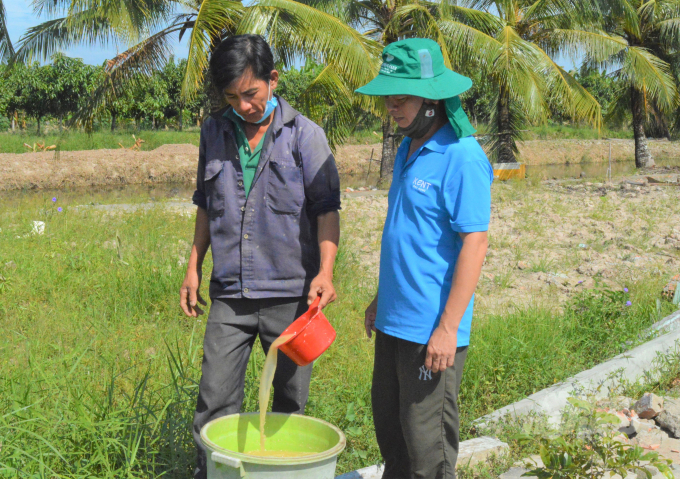
Nguyen Quoc Nam (right) guides farmers to create IMO. Photo: Trung Chanh.
The districts of U Minh Thuong region in Kien Giang Province, including An Bien, An Minh, U Minh Thuong and Vinh Thuan, are gifted by nature with the famous U Minh Thuong National Park. This is a large flooded Melaleuca forest with a high biodiversity, particularly many IMO living in the natural environment.
“Both useful and harmful IMO could be found anywhere, so the issue is whether we know how to isolate it and use it effectively or not,” said Nam. “And the important thing is how to do it quickly, easily, conveniently, cheaply, with quality and efficiency, so that farmers can also do it and apply it.”
Nam knows how to propagate IMO thanks to the guidance of MSc. Hoang Son Cong, a senior expert in the field of creative startups and agriculture in Vietnam, who is currently the Director of the Center for Entrepreneurship and Technology Transfer in the retail industry. Cong is also the founder of the Union of Kind Agriculture with spreading influences.
Since getting hold of the technique, Nam has shared with farmers elsewhere, especially those in his hometown in the U Minh Thuong region. Many farmers have supported and applied it effectively.
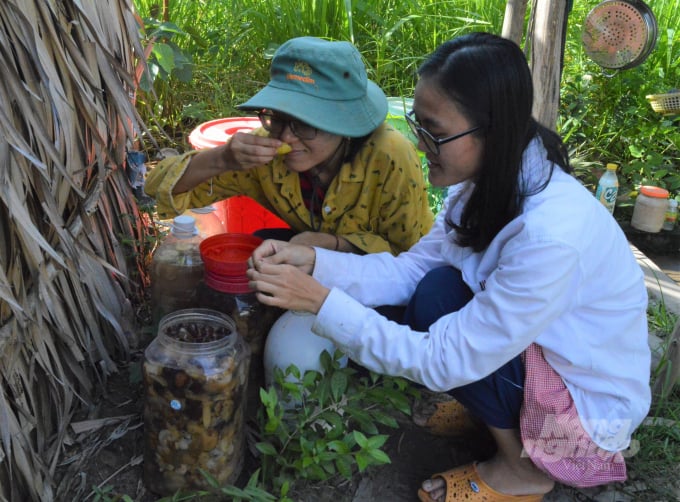
Composted IMO has the aroma of fermented vegetables, tubers and fruits, not the stinky aroma of garbage. Photo: Trung Chanh.
In Nam's houses in Thanh Yen Commune, U Minh Thuong District, and in many other houses in neighboring communes, cooking oil cans, paint cans, plastic buckets have been utilized to incubate IMO for practical application. The original IMO product will then be extracted and incubated with locally available vegetables, tubers and fruits, daily-life organic waste, trash fish, apple snails... before being used for various purposes. The incubating procedure varies depending on the purpose of use, but in general, it is pretty easy, cheap but effective.
According to Nam, the creation of IMO is quite simple. The needed materials include a 20-liter container, about 17 liters of dechlorinated water, 50 grams of rice bran, 1 liter of molasses, 3 yogurt cups, 5 large pieces of crushed wine yeast, 2 peeled and pounded ripe bananas, one chopped pineapple with peel (can be replaced with mango, dragon fruit, longan ...), peeled and crushed Annona glabra, 100g pounded ginger root, 5 packets of digestive enzymes (bought at the pharmacy).
All the ingredients are put in the bucket, mixed with water and stirred well. The container is closed with a lid but not too tightly so that the oxygen could enter. After being dried in the sun for two hours, the container is placed in the shadow for 7 days and stirred once every two days.
After 2-3 days, the ingredients smell sour and sweet and air bubbles appear on the surface, being ready to be used. The brewed mixture is diluted with clean water at a ratio of 1/10 and sprayed on garbage, pig manure, chicken .... The procedure is successful if the odor disappears.
Learning how to incubate IMO under Nam's guidance, Nguyen Hoang Vu from Cong Su Hamlet, An Minh Bac Commune, U Minh Thuong District has effectively applied it to his family's shrimp farming for 2 years.
A large container of IMO is placed right next to the shrimp pond at the back of his house. When its lid is open, one could smell the aroma of fermented vegetables, tubers and fruits instead of the stinky aroma of the garbage.
Vu said his family used to spend at least VND6-7 million buying probiotics and water treatment agents for their 1 hectare shrimp farming area. However, they have to spend less than VND 500,000 by using IMO while its usage is more convenient.
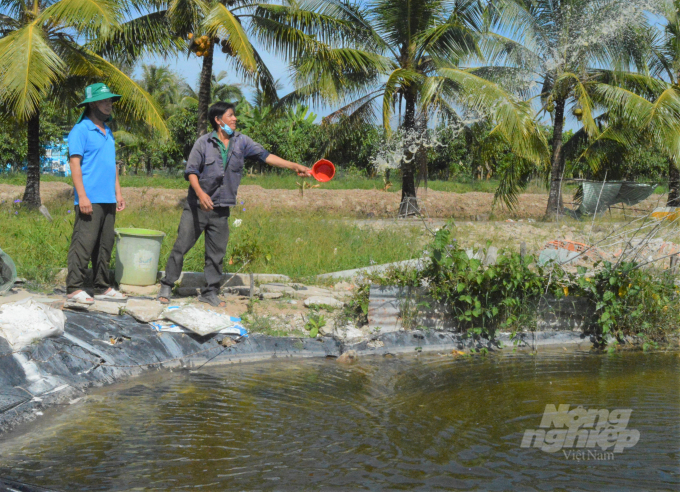
Nguyen Hoang Vu (right) has applied IMO to his family's shrimp farming for 2 years now, with low cost but high efficiency. Photo: Trung Chanh.
Vu's method is also quite simple: IMO is extracted and incubated with banana tree carcasses, ripe bananas, pineapples, rice bran, molasses... for one week then it can be used to throw in the pond to treat the water environment very effectively.
If it is mixed with shrimp food, it should be brewed with pureed ginger root, which is very good for the digestive system and common intestinal diseases.
If it is used to fertilize plants around shrimp ponds or ornamental flowers around the house, it should be incubated with trash fish caught from shrimp ponds.
“Most of the locals raise giant freshwater prawns and white leg shrimp. When the shrimp are nearly ready for harvesting, the farmer's biggest fear is that the shrimp will die due to oxygen shortage.
“The reason is that when the shrimp is large, the volume in the pond will be much, producing much waste, polluting the water environment and producing toxins.
“However, due to the impact of the COVID-19 pandemic, I could not sell giant freshwater shrimp. The shrimp is contained in the pond, developing up to 8-10 shrimp/kg (normally 12-15 shrimps could be harvested), but they could still grow well thanks to the clean and fresh water environment,” Vu talked about his family’s model to demonstrate the effectiveness of using IMO.
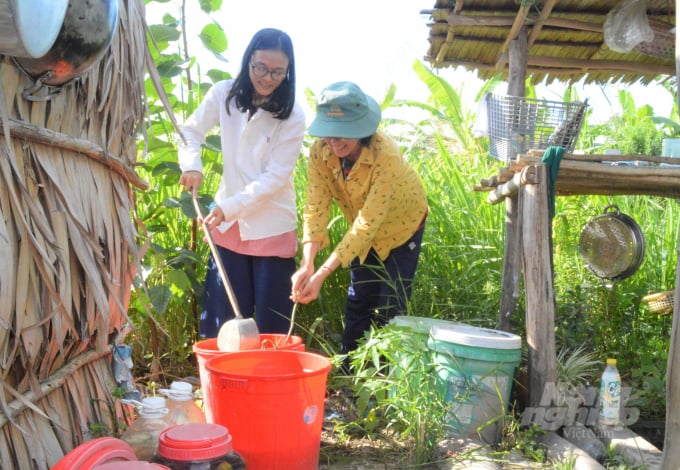
Le Thi Thu Thuy and Tran Thi Quynh Chinh have successfully created dishwashing liquid and organic fertilizer for vegetables and herbal gardens after learning about IMO. Photo: Trung Chanh
Two Vu’s neighbors, Le Thi Thu Thuy and Tran Thi Quynh Chinh, have successfully created dishwashing liquid and organic fertilizer for vegetables and herbal gardens after learning about IMO.
“Located at the heart of U Minh Thuong National Park, this area has many fruits and plants producing biomass that can be incubated with IMO. This method is not too difficult, cheap while reducing environmental pollution and improving local life,” Chinh said.
Translated by Phuong Ha
![Turning wind and rain into action: [4] Bringing climate bulletins to remote and isolated areas](https://t.ex-cdn.com/nongnghiepmoitruong.vn/608w/files/linhnhp/2025/06/14/1152-z6704423696987_15fd32ffc26d590d204d520c9dac6786-nongnghiep-151141.jpg)
(VAN) The Vietnam Agriculture and Nature Newspaper interviewed Mr. Vu Thai Truong, Acting Head of Climate Change and Environment at UNDP Vietnam, to gain deeper insight into how climate bulletins are delivered to farmers.
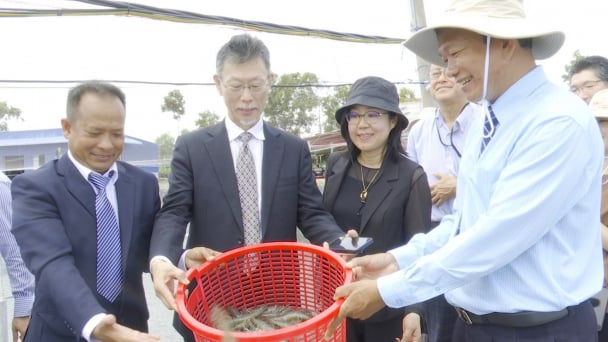
(VAN) In Tien Giang, a high-tech shrimp farm has developed a distinctive energy-saving farming model that has yielded promising results.
![Turning wind and rain into action: [3] 300.000 farmers benefit from agro-climatic bulletins](https://t.ex-cdn.com/nongnghiepmoitruong.vn/608w/files/news/2025/06/12/e5a48259d6a262fc3bb3-nongnghiep-125122.jpg)
(VAN) The agro-climatic bulletin has become a valuable tool for farmers in the Mekong Delta. After more than five years of implementation, the initiative is gradually being expanded nationwide.
![Turning wind and rain into action: [2] Providing forecasts to the people](https://t.ex-cdn.com/nongnghiepmoitruong.vn/608w/files/news/2025/06/12/e5a48259d6a262fc3bb3-nongnghiep-103927.jpg)
(VAN) In addition to improving the quality of hydrometeorological forecasts, putting forecast bulletins into practical use is crucial for production and disaster prevention.
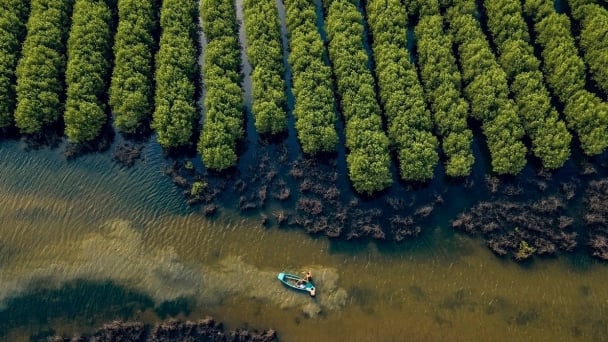
(VAN) Blue carbon is receiving attention for its rapid absorption capacity and vast potential. It represents a promising nature-based solution to respond to climate change.
/2025/06/11/3507-1-161904_583.jpg)
(VAN) Seagrass beds and coral reefs serve as 'cradles' that nurture life in the ocean depths, creating rich aquatic resources in Vietnamese waters.
![Turning wind and rain into action: [1] Forecasting for farmers](https://t.ex-cdn.com/nongnghiepmoitruong.vn/608w/files/news/2025/06/11/e5a48259d6a262fc3bb3-nongnghiep-111919.jpg)
(VAN) Weather is no longer just a matter of fate. Forecasts have now become an essential companion for farmers in every crop season.